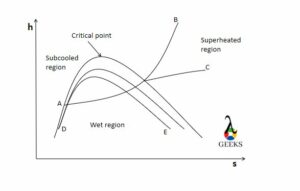Steam can occur as in various forms depending on temperature and pressure. This article discusses on the topic saturated vs superheated steam.
Saturated steam is the steam in which water exists in both liquid and gaseous state whereas Superheated steam is the steam whose temperature is above vaporization point.
What is saturated steam?
As discussed above, saturated steam is the condition where gaseous and liquid water co-exist. The temperature at which this happens is called as saturation temperature and pressure at which this happens is called saturation pressure.
When we say that both phases of water co exist, it means that the liquid water is in a transition state. The liquid water starts getting converted to gaseous state. If we decrease the temperature, the gas particles will condense to become liquid, if we heat it further then the saturated steam become superheated steam.
Effect on saturation temperature with changing pressure
When we change pressure of the system, the saturation temperature also changes. At lower pressure, the saturation temperature is also less. For example, if we go to higher altitudes where the pressure is low, water will start boiling sooner.
The enthalpy of steam first increases with increasing pressure, after some point it starts decreasing with pressure. This change can be represented on Mollier diagram (discussed in further sections).
What is superheated steam?
As discussed above, superheated steam occurs when temperature of the steam is raised above the vaporization point. In this state of steam, all the liquid particles turn to gas.
The enthalpy of superheated steam is much higher than saturated steam for a given pressure and temperature. It can be shown on Mollier diagram. Mollier diagram is discussed in detail in later section of this article.
Enthalpy-Entropy diagram/ Mollier diagram
The characteristics of steam can be plotted on h-s diagram also called as Mollier diagram named after the Richard Mollier who plotted the diagram in 1904.
The diagram consists a set of curves that represents different characteristics of steam. The details about curves are given below-
- Horizontal axis represents entropy (s).
- Vertical axis represents enthalpy (h).
- Line A-B represents constant pressure line.
- Line A-C represents constant temperature line.
- The dome represents saturated vapour line.
- Internal lines (D-E) making a similar dome are constant dry fraction lines.
- The tip of saturated vapour curve represents critical point.
- Region on the left side of saturated vapour curve is sub cooled region.
- Region inside the saturated vapour curve is saturated region.
- Region on the right side of saturated vapour curve represents superheated region.
Note that constant pressure line and constant temperature line are parallel inside the saturated vapour dome.

Saturated and superheat steam conditions
Using the Mollier diagram we can find out the conditions required for saturated and superheat regions.
First we find the condition for saturated steam. For saturated steam condition, the dryness fraction of the steam should be between 0 and 1. For superheated steam, the dryness fraction of the steam should be greater than 1.
In a nutshell,
For saturated steam at given saturation temperature and pressure- 0<x<1
For superheated steam at a given temperature and pressure- x>1
Where x denotes the dryness fraction.
What is dryness fraction?
Saturated steam is a mixture of both water and steam. To find the amount of steam present in the mixture, the term dryness fraction is used.
This term helps in giving an accurate data of steam characteristics. Without this term, characteristics of water would also come into play. Dryness fraction is the amount of dry steam present in the water-steam mixture.
Mathematically,
x = mdrystream/mmixture
This term helps in finding the actual enthalpy of steam and determines the quality of steam. Quality in terms of quantity of steam in the mixture. 100% quality implies the dryness fraction is 1 and the mixture contains only dry steam.
Why is the heat transfer co efficient of saturated steam higher than a superheated steam?
Saturated steam is better at heat transfer than superheated steam.
Superheated steam is a bad conductor of heat and has low thermal conductivity which means it will have low heat transfer co efficient. Saturated steam has better thermal conductivity due to liquid and gas particles mixture. Liquid water being a good conductor of heat, increases the overall heat transfer co efficient of saturated steam.
Due to above reasons, saturated steam has higher heat transfer co efficient than superheated steam.
Hi ….I am Abhishek Khambhata, have pursued B. Tech in Mechanical Engineering. Throughout four years of my engineering, I have designed and flown unmanned aerial vehicles. My forte is fluid mechanics and thermal engineering. My fourth-year project was based on the performance enhancement of unmanned aerial vehicles using solar technology. I would like to connect with like-minded people.